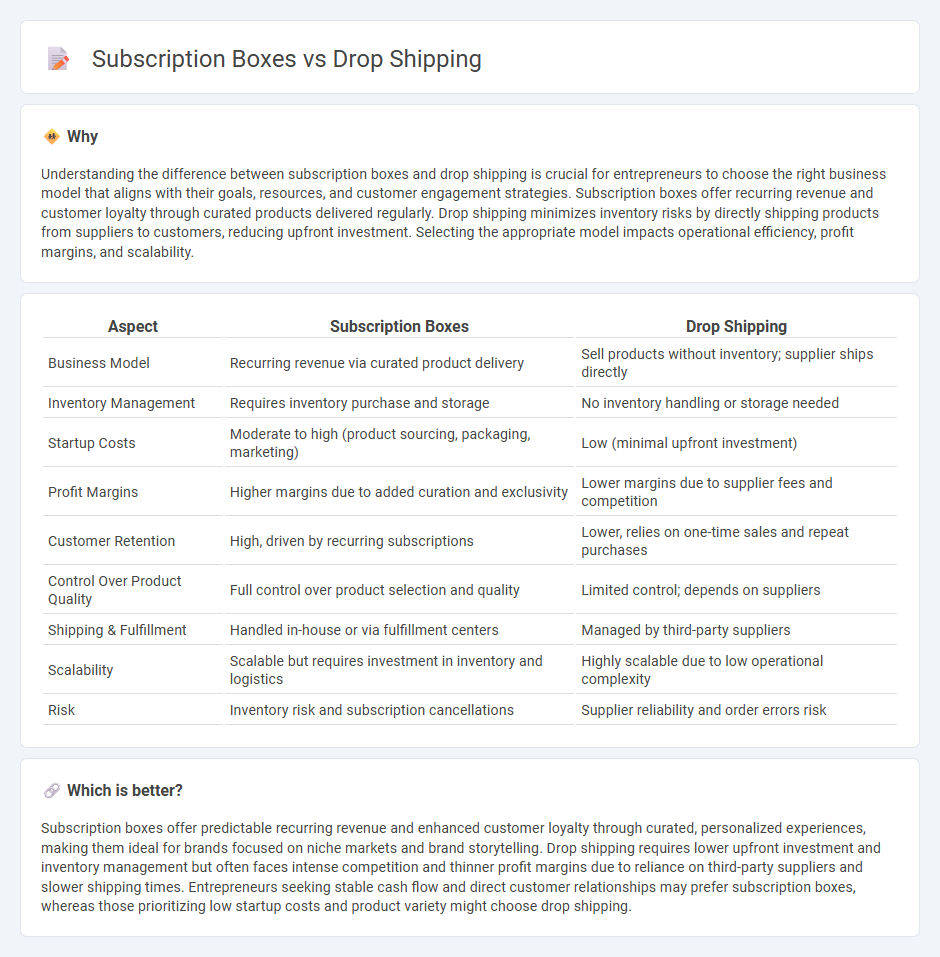
Subscription boxes offer entrepreneurs a unique opportunity to build brand loyalty through curated, recurring product deliveries, creating consistent revenue streams and customer engagement. Drop shipping eliminates inventory management by directly shipping products from suppliers to customers, reducing upfront costs and operational complexities. Explore the advantages and challenges of subscription boxes versus drop shipping to determine the best model for your business goals.
Why it is important
Understanding the difference between subscription boxes and drop shipping is crucial for entrepreneurs to choose the right business model that aligns with their goals, resources, and customer engagement strategies. Subscription boxes offer recurring revenue and customer loyalty through curated products delivered regularly. Drop shipping minimizes inventory risks by directly shipping products from suppliers to customers, reducing upfront investment. Selecting the appropriate model impacts operational efficiency, profit margins, and scalability.
Comparison Table
| Aspect | Subscription Boxes | Drop Shipping |
|---|---|---|
| Business Model | Recurring revenue via curated product delivery | Sell products without inventory; supplier ships directly |
| Inventory Management | Requires inventory purchase and storage | No inventory handling or storage needed |
| Startup Costs | Moderate to high (product sourcing, packaging, marketing) | Low (minimal upfront investment) |
| Profit Margins | Higher margins due to added curation and exclusivity | Lower margins due to supplier fees and competition |
| Customer Retention | High, driven by recurring subscriptions | Lower, relies on one-time sales and repeat purchases |
| Control Over Product Quality | Full control over product selection and quality | Limited control; depends on suppliers |
| Shipping & Fulfillment | Handled in-house or via fulfillment centers | Managed by third-party suppliers |
| Scalability | Scalable but requires investment in inventory and logistics | Highly scalable due to low operational complexity |
| Risk | Inventory risk and subscription cancellations | Supplier reliability and order errors risk |
Which is better?
Subscription boxes offer predictable recurring revenue and enhanced customer loyalty through curated, personalized experiences, making them ideal for brands focused on niche markets and brand storytelling. Drop shipping requires lower upfront investment and inventory management but often faces intense competition and thinner profit margins due to reliance on third-party suppliers and slower shipping times. Entrepreneurs seeking stable cash flow and direct customer relationships may prefer subscription boxes, whereas those prioritizing low startup costs and product variety might choose drop shipping.
Connection
Subscription boxes and dropshipping share a direct supply chain model that reduces inventory management costs and streamlines product delivery. Entrepreneurs utilize dropshipping suppliers to source products for subscription boxes, enabling scalable and flexible business operations without upfront inventory investment. This integration enhances customer satisfaction by providing curated, timely products while minimizing risk and operational overhead.
Key Terms
Inventory Management
Dropshipping eliminates the need for inventory management by allowing retailers to fulfill orders directly from suppliers, reducing storage costs and minimizing stockouts. Subscription boxes require careful inventory planning to ensure the right products are sourced and stocked to meet recurring customer demand and prevent fulfillment delays. Explore detailed strategies and technologies for optimized inventory management in both business models.
Customer Retention
Subscription boxes foster customer retention by delivering curated, personalized experiences that encourage ongoing engagement and predictable revenue streams, contrasting with dropshipping's one-off purchase model, which often suffers from inconsistent customer loyalty due to lack of brand connection. Dropshipping relies on third-party inventory and limited control over product quality and delivery, hindering the ability to build strong, repeat customer relationships. Explore strategies to enhance customer retention in both business models for sustainable growth.
Fulfillment Model
Dropshipping fulfillment relies on direct shipping from suppliers to customers, eliminating inventory management and reducing upfront costs. Subscription box fulfillment involves curating, packaging, and shipping products on a recurring schedule, requiring warehousing and personalized assembly. Explore detailed comparisons of fulfillment efficiencies, inventory control, and customer experience in dropshipping versus subscription box models.
Source and External Links
Drop shipping - Wikipedia - Drop shipping is a retail business model where the seller accepts customer orders without holding inventory, passing orders to manufacturers or wholesalers who ship directly to customers, minimizing overhead but reducing seller control.
What Is Dropshipping and How Does It Work? (2025) - Shopify - Dropshipping involves partnering with suppliers who handle storage, packaging, and shipping; the store owner markets products and forwards orders to suppliers, who ship directly to customers, simplifying ecommerce startup.
What Is dropshipping? How does it work in 2025? - Amazon Seller Central - Dropshipping is a fulfillment model outsourcing product handling and shipping to third parties, allowing sellers to operate without inventory, but potentially leading to low profit margins and less brand control.
 dowidth.com
dowidth.com